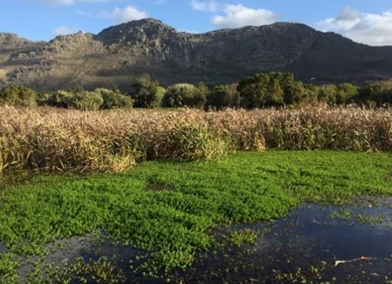1 November 2016 | By Jaco Le Roux
High specialisation characterises the relationships between native and invasive legumes and their mutualistic bacteria called rhizobia. This was the main finding of a recent paper by C·I·B core team member, Prof Jaco Le Roux and colleagues, that describes how plant-microbial networks are affected by invasive alien species.

Mutualistic relationships are when two organisms of different species “work together” and both benefit from the relationship. For example, legumes (plants from the family Fabaceae) form mutualistic networks with bacteria in the soil called rhizobia. Rhizobia can fix gaseous nitrogen from the atmosphere turning it into a form of nitrogen that can be used by the legumes. In return, the legumes provide the rhizobia with carbon.
How well these relationships works can determine how successful an invasive species can be in a new area. It is therefore important to understand the networks between rhizobia and legumes. In their study, and the first of its kind, Le Roux and colleagues looked at legume-rhizobium networks and how they respond to invasions of Australian acacias in South Africa.
They found that the hypotheses for mutualistic networks above the ground (e.g. pollination of plants by birds) may not hold for their counterparts in the soil. When assessing the legume-rhizobium relationships in sites invaded by acacias and in sites without acacias, they found that the relationships are highly specialised.
“This means that invasive acacias do not infiltrate existing relationships between native legumes and their associated rhizobia, but rather form unique and novel relationships, possibly because the associated rhizobia have been co-introduced with acacias to South Africa” explains Le Roux, lead author of the paper published in AoB PLANTS.
These findings are in stark contrast to the expectation from aboveground mutualistic interaction webs and their responses to invasive species; that generalised mutualist requirements facilitate infiltration of invasive species into existing native species interaction webs.
The acacias also appear to change the composition of rhizobia which means that native legumes interact with a different suite of rhizobia in invaded areas compared to uninvaded areas.
Le Roux commented on the relevance of this study: “In a broader sense, our paper illustrates a previously overlooked way in which biodiversity is impacted by biological invasions, with potentially important implications for ecosystem management and restoration of the services they provide. Our paper sets the stage for important and much needed future research efforts to better understand how plant-microbial interactions impacts on the structure plant communities and how these may react to forces of global change.”
Read the paper in AoB PLANTS
For more information, contact Jaco Le Roux at jleroux@sun.ac.za



